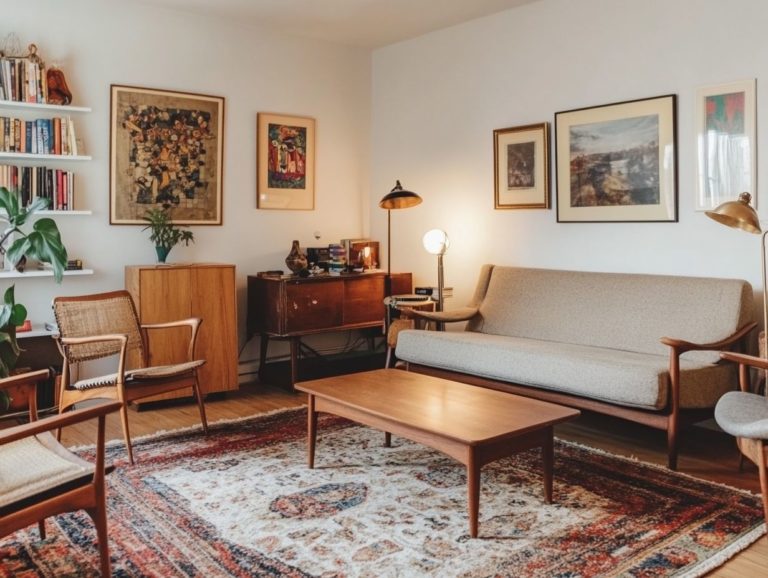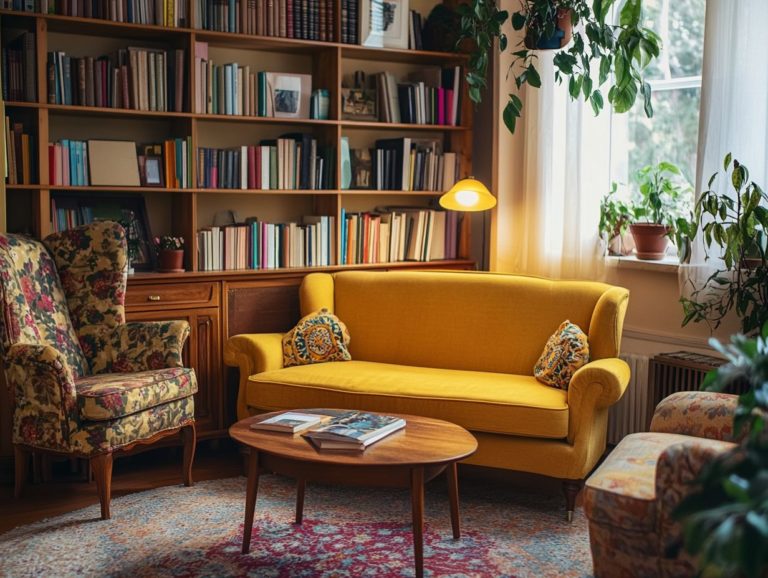The Role of Vintage Furniture in Eco-Friendly Homes
Vintage furniture transcends mere charm; it serves as a cornerstone of eco-friendly living.
As you explore the defining characteristics of vintage pieces and their environmental significance, you ll uncover how integrating these timeless treasures into your home can minimize waste while celebrating unique histories.
Get ready to transform your space with this guide! It provides expert advice on sourcing and restoring furniture, along with sustainable care techniques, empowering you to create a stylish and environmentally conscious space.
Contents
Key Takeaways:

- Using vintage furniture in eco-friendly homes helps reduce waste and protect our planet.
- Vintage furniture preserves history and adds unique style to homes, giving a sense of character and personality.
- Proper maintenance and cleaning techniques are essential for caring for vintage furniture, ensuring its longevity and reducing the need for new furniture production.
What is Vintage Furniture?
Vintage furniture includes pieces that are at least 20 years old, celebrated for their distinctive looks and exceptional quality. This category covers a range of styles, from timeless antique furniture to the iconic designs of the mid-century era, each boasting its unique charm and historical significance.
Vintage items often showcase superior craftsmanship, reflecting an era when durability and longevity were pivotal in furniture making. These pieces fulfill functional roles while also promoting sustainable living by encouraging resource conservation and minimizing waste typically generated by modern manufacturing practices.
Defining Characteristics
The defining characteristics of vintage furniture include a unique aesthetic, exceptional craftsmanship, and enduring durability that truly set it apart from modern pieces. Each item often displays distinct design patterns that capture the artistic trends of its time, making them conversation starters.
The materials used solid woods and genuine leather not only provide rich texture but also contribute to their longevity. You can see the quality in the meticulous detailing and construction techniques, which are often lacking in contemporary mass-produced items.
These qualities enhance their appeal and support sustainability, as vintage furniture usually needs less frequent replacement, thereby reducing waste and conserving resources.
The Environmental Impact of Furniture Production
The environmental impact of furniture production is significant, involving various critical factors like manufacturing emissions, waste generation, and the overall carbon footprint related to the lifecycle of furniture items.
Statistics and Facts
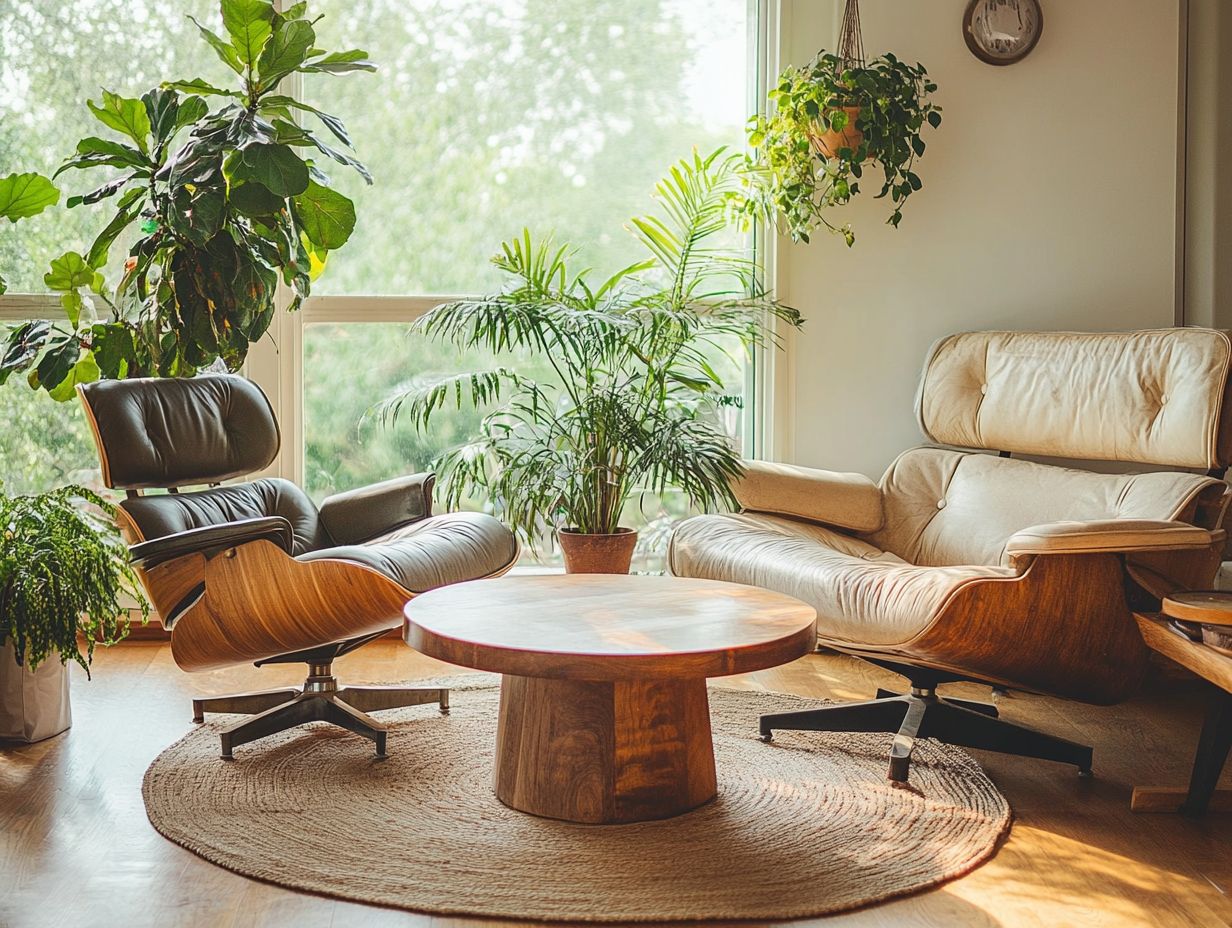
Statistics reveal that furniture production generates a large portion of global carbon emissions, highlighting the urgent need for sustainable practices in the industry.
Recent studies show that the furniture industry produces about 1.5 billion tons of CO2 each year a staggering figure that underscores the environmental urgency of the issue. This sector also generates around 100 million tons of waste annually, with much ending up in landfills, worsening the problem.
On the flip side, adopting sustainable practices like recycling and restoration can dramatically change these figures. For instance, restoring vintage furniture not only reduces waste but can also cut emissions by up to 80%, all while adding unique character to your home. Embracing vintage options actively contributes to lowering the overall environmental footprint associated with new production.
Benefits of Using Vintage Furniture
Choosing vintage furniture is a smart choice for you and the planet. It significantly reduces waste generation and lowers your carbon footprint. By opting for these timeless pieces, you enhance your space and engage in sustainable practices that support environmental sustainability.
Reducing Waste and Carbon Footprint
Vintage furniture plays a crucial role in reducing waste and minimizing carbon footprints by conserving resources and promoting reuse and recycle efforts.
When you choose to invest in vintage pieces instead of new furniture, you actively engage in a movement that prioritizes sustainability. Giving these timeless items a second chance helps divert them from landfills and sidestep the heavy resource consumption tied to manufacturing new products.
This thoughtful decision not only decreases the demand for raw materials but also mitigates the environmental pollution that comes with industrial production.
Embracing second-hand items isn’t just a stylish fashion statement; it’s a meaningful step toward conscious living, aligning your consumer choices with the principles of eco-friendliness and mindful consumption. Additionally, understanding the value of vintage furniture can enhance your commitment to sustainable choices.
Preserving History and Unique Style
Preserving history through vintage furniture does more than elevate your unique style; it honors cultural heritage and craftsmanship, transforming each piece into a story waiting to be told.
These remarkable items serve as tangible connections to the past, allowing you to glimpse the aesthetic values and societal influences of the times from which they originate. Picture the ornate details of Victorian-era chairs or the sleek, minimalist lines of mid-century modern tables.
Each era showcases its distinctive design trends, celebrating the creativity and resourcefulness of its craftsmen.
When you restore vintage furniture, you’re not just revitalizing its physical form; you’re sustaining its narrative significance. This ensures that future generations will appreciate the artistry and historical context intricately woven into every exquisite detail, highlighting the role of vintage furniture in sustainable living.
How to Incorporate Vintage Furniture in Your Home
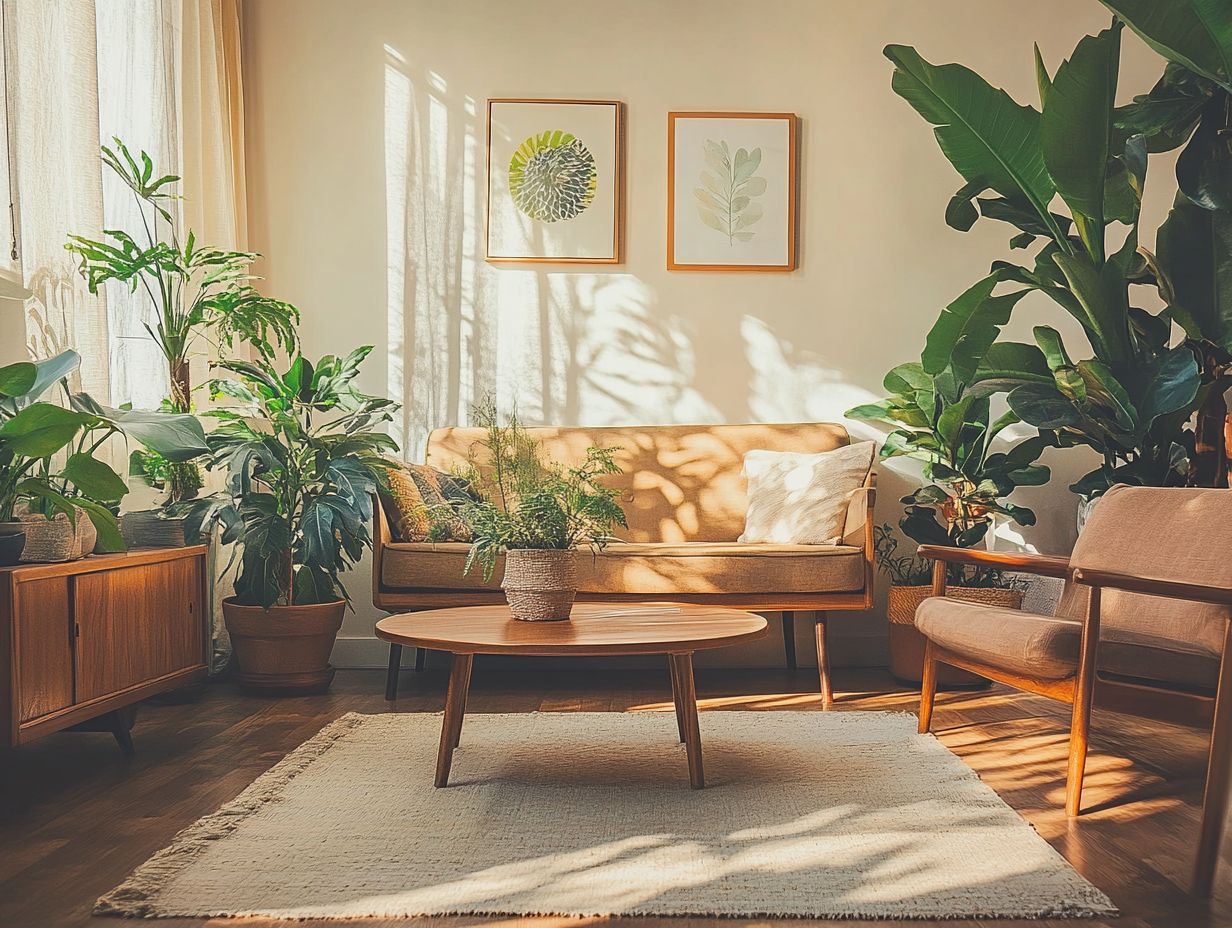
Incorporating vintage furniture into your home can truly transform your space, introducing a unique aesthetic that reflects your style. Not only does it enhance the beauty of your interior, but it also supports sustainable living practices.
This allows you to embrace thoughtful design choices that have a positive impact on the environment.
Tips for Finding and Restoring Pieces
Get ready for an exhilarating journey as you find and restore vintage furniture! It s filled with opportunities to uncover hidden gems in thrift stores and from local dealers.
To embark on this adventure, consider diving into estate sales and auctions, where you might discover unique pieces steeped in fascinating histories.
As you scout for vintage finds, pay close attention to the details: seek out quality craftsmanship, like strong joints and sturdy construction these are clear indicators of longevity and durability.
It’s crucial to assess a piece’s restoration potential. Keep an eye out for any significant damage and envision the possibilities for breathing new life into it.
Remember, investing in well-crafted furniture not only enhances your space but also promises lasting satisfaction for years to come.
Sustainable Practices for Caring for Vintage Furniture
Caring for vintage furniture requires embracing sustainable practices that not only enhance its longevity but also preserve its unique charm.
Make sure to give your vintage furniture the care it deserves! Focus on proper maintenance and cleaning techniques, ensuring that each piece remains a timeless treasure in your space.
Start your journey now by exploring vintage furniture shops or beginning a restoration project!
Proper Maintenance and Cleaning Techniques
Proper maintenance and cleaning techniques for vintage furniture are essential for preserving its quality and aesthetic. Often, these can be achieved through eco-friendly methods.
For your wood pieces, a routine of dusting with a soft cloth is crucial. Applying natural oils like lemon oil or beeswax can do wonders, enhancing their shine while protecting against drying and cracking.
If you re dealing with upholstered items, consider using a gentle, biodegradable fabric cleaner. This helps revitalize the fibers without causing harm.
For metal components, a simple wipe down with a vinegar and water solution can help prevent rust and restore their luster. By engaging in these regular maintenance habits, you maintain visual appeal and significantly extend the lifespan of these cherished vintage items.
Start your journey to preserving vintage treasures now!
Frequently Asked Questions
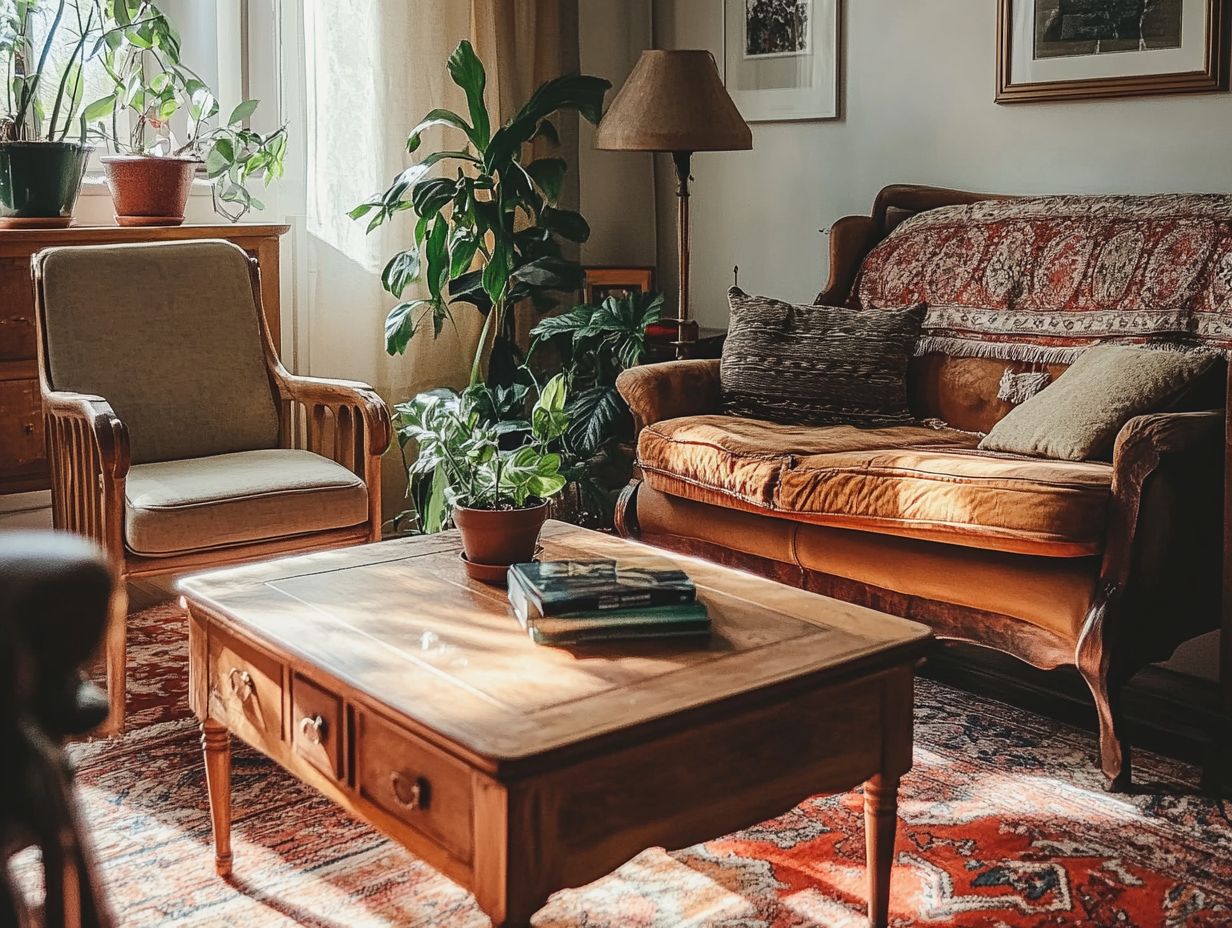
What is the role of vintage furniture in eco-friendly homes?
Vintage furniture plays a crucial role in making homes more eco-friendly. It reduces the demand for new furniture production and minimizes waste.
How does using vintage furniture contribute to sustainability?
By using vintage furniture, we reduce the need for new materials and resources. This effectively lowers the carbon footprint of furniture production while promoting a circular economy.
What makes vintage furniture a more sustainable choice compared to new furniture?
Vintage furniture often features high-quality materials and craftsmanship. This makes it more durable and long-lasting than new furniture, leading to less frequent replacements and reduced waste.
Can vintage furniture be considered a form of upcycling and a key element of sustainable living?
Absolutely! Using vintage furniture gives new life to old items and prevents them from ending up in landfills.
How can I incorporate vintage furniture into my eco-friendly home design?
Start by exploring second-hand or antique stores in your area for unique, sustainable pieces. You can also repurpose or restore old furniture to fit your design aesthetic.
What are some other benefits of using vintage furniture in eco-friendly homes, and how does it support local economies?
Vintage furniture adds character and charm to a home. It can also help save money compared to buying new items.


